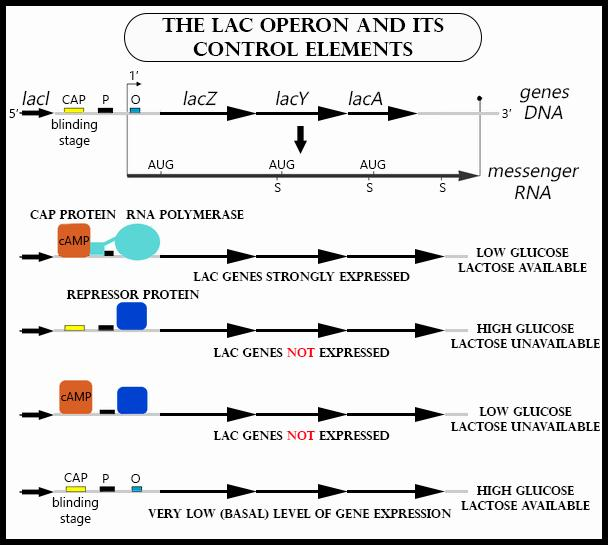
Explain the working of the lac operon with diagrammatic representation.
Answer
509.1k+ views
Hint: Operon refers to a set of functional genes (Transcription unit) required for the production of enzymes. They have a single promoter region. In operon the genes encode proteins that allow the bacteria to use lactose as an energy source.
Complete Answer:
The concept of Lac operon was given by Francois Jacob and Jacques Monod. Lac operon is an operon present predominantly in the prokaryotes like E. coli. It was the first gene regulatory process to be discovered in bacteria. It is associated with the regulation of lactose i.e. transport and metabolism.
-It consists of an operator, promoter, three structural genes, z, y, a, and a terminator.
-The three structural genes lacZ, lacY, lacA code for beta-galactosidase, galactoside permease, and galactoside acetyltransferase, respectively.
-The enzyme RNA polymerase binds to the promoter region (at 3’ end of template strand) and moves downstream, forming the desirable protein.
-The enzyme beta-galactosidase is responsible for the breakdown of disaccharide lactose into glucose and galactose. Permease is a cell membrane protein responsible for the entry of lactose into the cell. Acetyltransferase is responsible for the transfer of the acetyl group from acetyl-CoA to beta galactoside.
-The operon is active only in the presence of lactose.

Note: -Jacob and Monad were awarded the Nobel prize for the discovery of Lac operon in 1965.
-The lac operon remains in ‘off’ position. It means that the operon is negatively inducible due to the presence of a repressor gene i.e. ‘I’ gene. The depression molecule blocks the action of RNA polymerase. The repressor molecule can be removed only by an operator protein (coded by a gene ‘o’).
-The operator present in Lac operon is ‘Allolactose’.
Complete Answer:
The concept of Lac operon was given by Francois Jacob and Jacques Monod. Lac operon is an operon present predominantly in the prokaryotes like E. coli. It was the first gene regulatory process to be discovered in bacteria. It is associated with the regulation of lactose i.e. transport and metabolism.
-It consists of an operator, promoter, three structural genes, z, y, a, and a terminator.
-The three structural genes lacZ, lacY, lacA code for beta-galactosidase, galactoside permease, and galactoside acetyltransferase, respectively.
-The enzyme RNA polymerase binds to the promoter region (at 3’ end of template strand) and moves downstream, forming the desirable protein.
-The enzyme beta-galactosidase is responsible for the breakdown of disaccharide lactose into glucose and galactose. Permease is a cell membrane protein responsible for the entry of lactose into the cell. Acetyltransferase is responsible for the transfer of the acetyl group from acetyl-CoA to beta galactoside.
-The operon is active only in the presence of lactose.

Note: -Jacob and Monad were awarded the Nobel prize for the discovery of Lac operon in 1965.
-The lac operon remains in ‘off’ position. It means that the operon is negatively inducible due to the presence of a repressor gene i.e. ‘I’ gene. The depression molecule blocks the action of RNA polymerase. The repressor molecule can be removed only by an operator protein (coded by a gene ‘o’).
-The operator present in Lac operon is ‘Allolactose’.
Latest Vedantu courses for you
Grade 11 Science PCM | CBSE | SCHOOL | English
CBSE (2025-26)
School Full course for CBSE students
₹41,848 per year
Recently Updated Pages
Master Class 12 Business Studies: Engaging Questions & Answers for Success

Master Class 12 English: Engaging Questions & Answers for Success

Master Class 12 Social Science: Engaging Questions & Answers for Success

Master Class 12 Chemistry: Engaging Questions & Answers for Success

Class 12 Question and Answer - Your Ultimate Solutions Guide

Master Class 11 Economics: Engaging Questions & Answers for Success

Trending doubts
Which one of the following is a true fish A Jellyfish class 12 biology CBSE

Draw a labelled sketch of the human eye class 12 physics CBSE

a Tabulate the differences in the characteristics of class 12 chemistry CBSE

Why is the cell called the structural and functional class 12 biology CBSE

Differentiate between homogeneous and heterogeneous class 12 chemistry CBSE

What are the major means of transport Explain each class 12 social science CBSE




